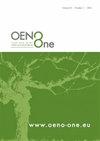Metagenomic ecosystem monitoring of soft scale insects and mealybug communities
IF 2.2
3区 农林科学
Q3 FOOD SCIENCE & TECHNOLOGY
引用次数: 0
Abstract
Soft scale insects and mealybugs are phloem-feeding Hemipterans that are considered major pests in agriculture and horticulture throughout the world. However, correct taxonomic identification in the field can be difficult, making it hard for growers to implement control strategies. In viticulture, soft scale insects are a major issue due to their ability to secrete honeydew, which facilitates the development of sooty mould, and their propensity for being transmission vectors of several viral diseases of grapevine. To facilitate the rapid identification and quantification of vineyard-associated insects a metagenomic-based bioinformatic pipeline (MitoMonitor) was developed for generalised ecosystem monitoring, which automated the assembly and classification of insect mitochondrial genomes from shotgun sequencing data using the Barcode of Life Database API. The proof-of-concept application of MitoMonitor on metagenomic data obtained from eight samples from South Australian vineyards led to the identification of Parthenolecanium corni (European fruit scale)—which was thought to be absent in Australian vineyards—as the dominant coccoid species across the samples, with less frequent, and also lower abundance of Pseudococcus viburni (obscure mealybug) and Pseudo. longispinus (long-tailed mealybug). In addition, parisitoidism by Coccophagus scutellaris (Aphelinidae) wasps was also detected. The discovery of Parth. corni as a member of scale communities in these samples has significant implications for the development of effective control strategies for this important group of pests in affected areas.软鳞翅目昆虫和蚧壳虫群落的元基因组生态系统监测
软鳞翅目昆虫和蚧壳虫是以韧皮部为食的半翅目昆虫,被认为是世界各地农业和园艺中的主要害虫。然而,田间正确的分类鉴定可能很困难,因此种植者很难实施控制策略。在葡萄栽培中,软鳞翅目昆虫是一个主要问题,因为它们能够分泌蜜露,这有利于煤烟霉的发展,而且它们容易成为多种葡萄病毒病的传播媒介。为了便于快速识别和量化与葡萄园相关的昆虫,开发了一个基于元基因组的生物信息学管道(MitoMonitor),用于普遍的生态系统监测,该管道利用生命条形码数据库应用程序接口(API),从枪式测序数据中自动组装和分类昆虫线粒体基因组。MitoMonitor 的概念验证应用于从南澳大利亚葡萄园的八个样本中获得的元基因组数据,结果发现 Parthenolecanium corni(欧洲果鳞)--被认为在澳大利亚葡萄园中不存在--是所有样本中最主要的茧类物种,而 Pseudococcus viburni(隐蔽蚧)和 Pseudo.此外,还发现了 Coccophagus scutellaris(Aphelinidae)小蜂的拟态现象。在这些样本中发现 Parth. corni 是鳞片群落中的一员,这对针对受影响地区的这一重要害虫群制定有效的控制策略具有重要意义。
本文章由计算机程序翻译,如有差异,请以英文原文为准。
求助全文
约1分钟内获得全文
求助全文
来源期刊

OENO One
Agricultural and Biological Sciences-Food Science
CiteScore
4.40
自引率
13.80%
发文量
85
审稿时长
13 weeks
期刊介绍:
OENO One is a peer-reviewed journal that publishes original research, reviews, mini-reviews, short communications, perspectives and spotlights in the areas of viticulture, grapevine physiology, genomics and genetics, oenology, winemaking technology and processes, wine chemistry and quality, analytical chemistry, microbiology, sensory and consumer sciences, safety and health. OENO One belongs to the International Viticulture and Enology Society - IVES, an academic association dedicated to viticulture and enology.
 求助内容:
求助内容: 应助结果提醒方式:
应助结果提醒方式:


